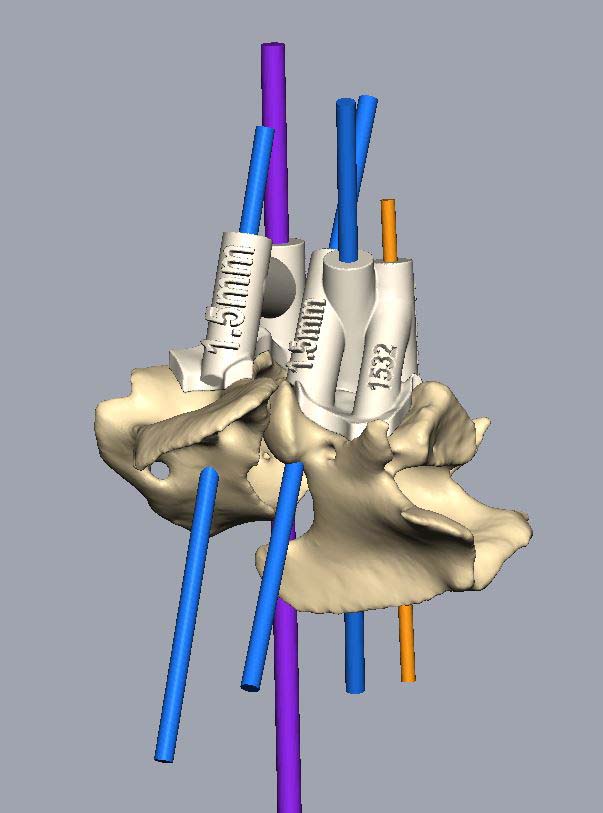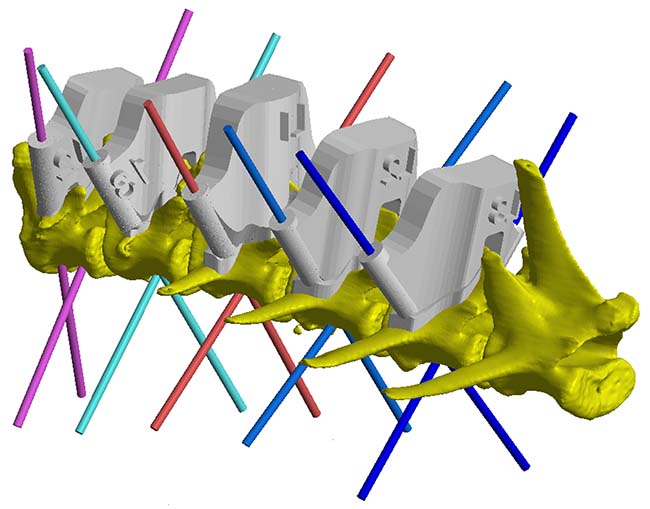16 Aug 2022
Companion animal neurology: a review of the latest thinking
Simona Radaelli explains how technological developments are aiding neurological advancements in small animal care.

Computer-aided design view of thoracolumbar junction (T12 to L4) with drill guides in situ and pilot hole trajectories planned across. Image © Vet3D / www.vet3D.co.uk
Small animal neurology is a specialism that is considered particularly challenging by veterinary surgeons in general practice. The complexity of the nervous system and the interpretation of the specific series of tests required to perform a neurological examination can deter the GP from managing patients with neurological signs.
Animals with neurological signs are often referred to referral centres, where the presence of neurology specialists and advanced diagnostic techniques are considered key for these patients.
Advanced diagnostic imaging, such as CT and MRI, is becoming more accessible to veterinary surgeons in general practice. This requires a direct access to specialists, as small animal neurologists, to guide the GP to manage the neurological patients.
The presence of specialists that can virtually guide the GP through the neurological examination, and discuss differential diagnoses and further tests, allows the patients that cannot be referred to access specialist care from their GP practice. This new virtual service allows the GPs to offer a specialist service to owners; discuss neurolocalisation, treatment and prognosis; and review the results of advanced imaging and ancillary tests with a neurology specialist.
The markedly disruptive lockdowns that have affected the world in the past two years have shown how useful and valuable the virtual guidance from specialists can be for patients that can be managed within the general practice.
Similarly to all the other disciplines, veterinary neurology is in constant evolution and efforts are canalised by scientists and neurologists alike to improve and discover new diagnostic and therapeutic methods to treat our neurological patients.
Collaborations between hospitals and referral centres nationally and internationally have proven to be key in unifying efforts and increasing chance for research success.
Genetic testing
Genetic testing and gene treatment has been one of the main focuses of research in medicine in recent years.
Early diagnosis of genetic conditions and early prediction of genetic predisposition to response to medical treatment of chronic diseases could prove to become a turning point in the diagnosis and treatment of some neurological conditions, such as idiopathic epilepsy.
The results of genetic studies should favour the development of more targeted and new therapeutic approaches to neurological diseases. The results of these studies could also ultimately benefit breeding regulations through screening and prevention of diseases.
Idiopathic epilepsy with a proven or suspected genetic background has been reported for some purebred dogs (the border collie and Italian spinone), but most studies have not yet identified causative gene mutations. An ongoing research study is, however, looking into identifying these gene mutations, using a genome-wide association study or genome scan.
For more information, visit www.canine-genetics.org.uk/research/epilepsy
Studies have reported genetic mutations associated with idiopathic epilepsy in the lagotto Romagnolo, Belgian shepherd dog and Rhodesian ridgeback, and the hypothesis is that epilepsy represents a complex disease with interaction of multiple genes and environmental factors.
Genetic testing to investigate pharmacoresistance to anti-epileptic drugs are also under way due to a suspected more complex cause of multi-drug resistance than simple drug metabolism (multidrug transporter hypothesis and drug target hypothesis of pharmacoresistance).
Genetic testing is widely used in veterinary medicine – often as screening for several breed-related genetic diseases. Its application in neurology has increased in recent years, helping veterinary neurologists to create customised treatment and early intervention.
Diet
The role of a balanced diet as supportive treatment to several chronic diseases is well-known in veterinary medicine (such as chronic kidney disease in cats and inflammatory bowel disease).
A study has shown the benefit of a ketogenic medium-chain triglyceride diet (MCTD) as an adjunctive method in dogs on anti-epileptic treatment. The MCTD resulted in a reduction in seizure frequency per month compared to the placebo-standardised diet (Law et al, 2015).
The use of an MCTD should not replace the anti-epileptic treatment, but only used as add-on supportive diet – especially in refractory patients or in patients receiving more than one anti-epileptic medication.
The beneficial effects of MCTD are supposed to be due to:
- The ability to increase ketone concentrations in the blood and, therefore, provide an alternative metabolic pathway. Ketogenic diets provide the ketone bodies acetoacetate and β-hydroxybutyrate, which can be used as auxiliary fuel by the brain.
- The ability to contribute to the maintenance of the neuronal structure via increasing concentrations of polyunsaturated fatty acids in the brain.
A commercial diet is now available for this purpose or MCT oil can be added to the normal diet at 1 teaspoon/10kg bodyweight of the dog twice daily. Some studies have also provided preliminary evidence of reduction in seizure frequency, compared with the placebo group, in epileptic dogs receiving cannabidiol-infused oil as a supplement twice daily, in addition to existing anti-epileptic treatment.
Larger studies and a standardised treatment protocol are needed to confirm the benefit of cannabidiol supplement in reducing seizure frequency and severity in dogs.
3D printing
The interest in the use of 3D printing in surgical treatment of neurological disease – especially spinal (vertebral malformations, fractures, instability/subluxation, wobbler syndrome) – has grown exponentially in the past few years, and techniques have been developed to ameliorate and customise its use.
Advanced imaging allows the diagnosis of several neurological conditions and the development of customised implants, with the use of 3D printers and computer-aided design software, which are becoming available for industrial and customer use.
Specific drill templates for spinal pedicle screw placement can be created with the use of a CT scan of the affected vertebrae. This allows accurate planning for the use of bicortical pedicle screws, that provide stronger fixation in comparison to lateral mass screws.
The drill guide and the vertebrae can be exported to 3D printing software and printed. The material used can vary depending on the printer and is usually a biocompatible resin (methacrylate photopolymer resin). They can be sterilised and used intraoperatively to guide the placement of the screws.
3D printing could be used to create patient-specific implants that can reproduce and be used to stabilise (3D-printed plates) vertebrae damaged by disease of malformations. Implantable polymers or titanium can be used for these patient-specific implants.


Rehabilitation
Rehabilitation following neurologic injury has been standard care in human medicine for decades, while similar physical therapy techniques have only recently been utilised in veterinary medicine.
The need for physical therapies in the rehabilitation of veterinary spinal patients has grown exponentially in the past decade.
Rehabilitation can be applied as a conservative, non-surgical option, in preoperative and postoperative settings, and to assist the management of palliative conditions.
The increase in client willingness and affordability to pursue surgical procedures in patients with spinal cord injury, the heightened perceived value of companion animals, and the desire to provide comprehensive and holistic medical care have increased demand for an integrative treatment approach in veterinary rehabilitation.
Rehabilitation and physical therapies, such as physiotherapy and hydrotherapy, have proven to be essential in the speed and degree of recovery also of neuromuscular diseases – especially in a recumbent patient. Physiotherapy and rehabilitation can improve functional status, alleviate pain and result in a better quality of life.
Customised physical therapy programmes are developed by the physiotherapist, following referral by the veterinary surgeon, to increase the chances of full or optimal recovery. Collaboration and good communication between owners, referral surgeons, nurses, and rehabilitation teams are essential to achieve the best results and avoid unwanted complications.
The physiotherapist uses specialised manual skills to evaluate and treat the neurologic patient. The techniques involve specific stretching, passive range of motion and massage. The use of thermal, sound, electrical and light therapy impacts the physiology of the target tissue, favouring the healing process.
Limited research exists in veterinary medicine on physical rehabilitation techniques that increase recovery after neurologic injury, but evidence supports the utilisation of an early, comprehensive treatment protocol for optimal neurologic recovery.
Techniques such as acupuncture, manual therapy, personalised therapeutic exercise programmes and laser therapy are widely used to treat veterinary patients with neurological conditions.
Future
Wearable medical devices with activity tracking capabilities to monitor dogs and cats for vital health and behaviour attributes (such as heart and respiration rates, pH levels and body temperature) are already being used in veterinary medicine. Their use could be extended and applied to patients with neurological diseases.
Predictive biomarkers are very useful in the early intervention, or even prevention, of common disorders – especially age-related, such as chronic kidney disease in cats. Their use in neurology could also help with assessing the risk of disease development, to allow early intervention and better outcome.
The future of veterinary medicine is focused on a more patient-centred and holistic approach to disease, with a focus on prevention and early detection of disease with genetic testing, markers and customised surgical techniques.
References
- Berk BA et al (2020). A multicenter randomized controlled trial of medium-chain triglyceride dietary supplementation on epilepsy in dogs, J Vet Intern Med 34(3): 1,248-1,259.
- Elford JH et al (2020). Accuracy of placement of pedicle screws in the thoracolumbar spine of dogs with spinal deformities with three-dimensionally printed patient-specific drill guides, Vet Surg 49(2): 347-353.
- Fender K (2020). Innovations to watch in veterinary medicine, Today's Veterinary Business.
- Gamble L-J (2022). Physical rehabilitation for small animals, Vet Clin North Am Small Anim Pract 52(4): 997-1,019.
- Frank LR and Roynard PFP (2018). Veterinary neurologic rehabilitation: the rationale for a comprehensive approach, Top Companion Anim Med 33(2): 49-57.
- Hamilton-Bennett SE et al (2018). Accuracy of a patient-specific 3D printed drill guide for placement of cervical transpedicular screws, Vet Surg 47(2): 236-242.
- Han FY et al (2021). Dietary medium chain triglycerides for management of epilepsy: new data from human, dog, and rodent studies, Epilepsia 62(8): 1,790-1,806.
- Hülsmeyer V-I et al (2015). International Veterinary Epilepsy Task Force’s current understanding of idiopathic epilepsy of genetic or suspected genetic origin in purebred dogs, BMC Vet Res 11: 175.
- Law TH et al (2015). A randomised trial of a medium‑chain TAG diet as treatment for dogs with idiopathic epilepsy, Br J Nutr 114(9): 1,438-1,447.
- Lowrie M (2018). Canine epilepsy innovations, Vet Times 48(45): 14-16.
- McGrath S et al (2019). Randomized blinded controlled clinical trial to assess the effect of oral cannabidiol administration in addition to conventional antiepileptic treatment on seizure frequency in dogs with intractable idiopathic epilepsy, J Am Vet Med Assoc 254(11): 1,301-1,308.
- Morrow L and Belshaw Z (2020). Does the addition of cannabidiol to conventional antiepileptic drug treatment reduce seizure frequency in dogs with epilepsy? Vet Rec 186(15): 492-493.
- Behr S et al (2016). 3D printing: future of advanced spinal surgery in small animals, Vet Times 46(47): 14.
- Radaelli ST (2022). Understanding epilepsy in dogs, Vet Times 52(16): 6-10.
- Seppälä EH et al (2011). LGI2 truncation causes a remitting focal epilepsy in dogs, PLOS Genet 7(7): e1002194.
- Toni C et al (2020). Atlanto-axial ventral stabilisation using 3D-printed patient-specific drill guides for placement of bicortical screws in dogs, J Small Anim Pract 61(10): 609-616.
- Toni C et al (2021). Accuracy of placement of pedicle screws in the lumbosacral region of dogs using 3D-printed patient-specific drill guides, Vet Comp Orthop Traumatol 34(1): 53-58.
